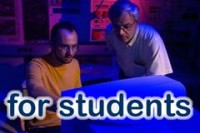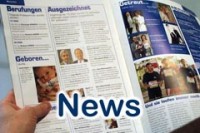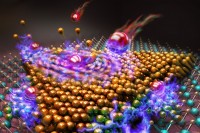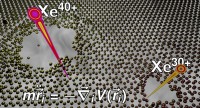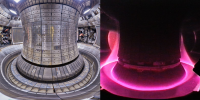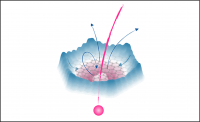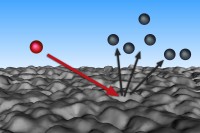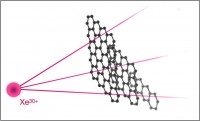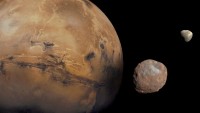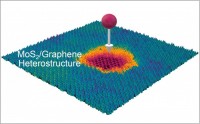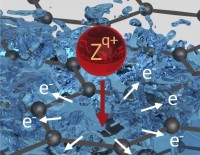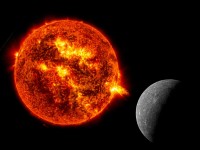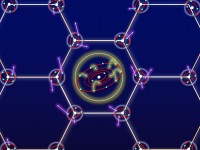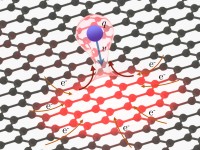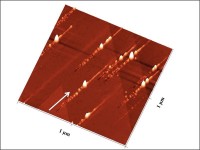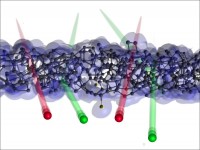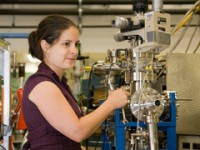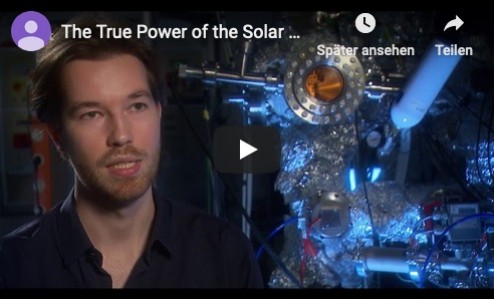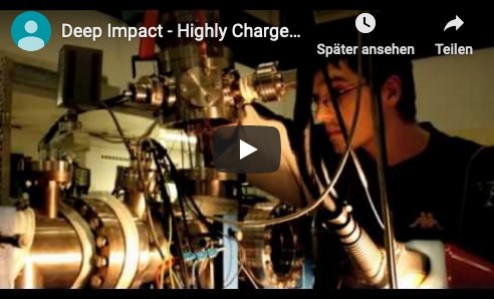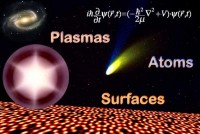LEGACY Page (as of 1.1.2024)
Please visit our new website at https://www.tuwien.at/phy/iap/atomic-and-plasma-physics
Atomic and Plasma Physics
head (until 30.09.2023): Fritz Aumayr
head (from 01.10.2023): Richard Wilhelm
professors: Fritz Aumayr, Ille Gebeshuber, Wolfgang Werner, Richard Wilhelm
emeriti: Wolfgang Husinsky, Johann Laimer
Research Highlights
Highly charged ions melt gold nanoislands
Nanoisland structures made of gold can be specifically manipulated by ion bombardment. As shown in a publication of our group in the journal Small, surprisingly (for others but not for us), the decisive factor is not the force of the impact but the charge state of the projectile ions. Read more
Nanopore Formation in 2D materials
A new model published by our group in Nano Letters explains, why tiny holes - only a few nanometers in size - are formed in some two-dimensional materials when they are bombarded with highly charged ions, but not in others. This basically depends on the electron mobility in the material and the charge state of the projectile. The effect of nano-hole formation could be exploited, e.g., to produce novel sieves for certain molecules. Read more
Nuclear fusion: A new solution for the instability problem
For fusion reactors like ITER, plasma instabilities are a major challenge. Now our group at IAP/TU Wien together with IPP Garching) could demonstrate: There is an operational regime for fusion reactors that avoids this problem. Instead of large potentially destructive instabilities, one intentionally accepts many small instabilities that do not pose a problem for the reactor’s walls. The results have now been published in Physical Review Letters and featured in Physics (APS) as well as PhysicsWorld (IOP). Read more.
Studying ultrafast charge dynamics in 2D materials
When ions penetrate a material, highly complex processes take place - so fast that they could hardly be studied until now. In a recent paper in Physical Review Letters we now analyze on a time scale of one femtosecond what happens to the individual particles involved, when an ion penetrates 2 dimensional materials such as graphene or molybdenum disulphide. Read more
A sandblaster at the atomic level
Beams of energetic ions are used to clean or nanostructure various materials via sputtering. In a recent paper in Applied Surface Science we are able to explain how the sputtering process depends on the roughness of the surface. Using experiments and simulations we show show that the mean inclination angle of the surface (accessibly e.g. by atomic force microscopy or other high resolution microscopy methods) describes the final outcome of the sputtering process much better than other roughness parameters that have been used so far. Read more
How ions get their electrons back
What happens when ions are passing through solid materials? It is nearly impossible to observe this directly, but now our group has found a way to overcome this problem. By peeling graphite layer by layer we uncovered how ions recapture their electrons when moving through solid material. The new measurements reported in the Nature Journal "Communications Physics" show that the ions obey remarkably simple laws. Read more or learn what the popular science journal "Scientific American" has to say about our research.
Unraveling the mystery of the Mars moon Phobos
What causes the “space weathering” on the Mars moon Phobos? Results of laboratory experiments performed in our group and reported in the Journal of Geophysical Research: Planets give new insights and show that beside the solar wind also the irradiation by particles from Mars plays a decisive role there. These considerations could soon play an important role in the evaluation of real Phobos samples since in 2024 a Japanese space mission will take soil samples from Phobos and bring them back to Earth. Read more
Nanocarving of world's thinnest materials
Carving well-defined holes into a stack of 2D materials is not an easy task, especially if only one atomic layer shall be modified not harming any material underneath. With slow highly charged ions we are able to achieve this ultimate surface sensitivity, an unprecedented precision in nanoscience so far. Read more or study our publication in ACS Nano.
Slow electrons for cancer treatment
Ion beam radiation therapy uses complicated atomic-physical effects to fight cancer cells. In a recent paper in The Journal of Physical Chemistry Letters our group has now identified a new mechanism that directly emits low energy electrons, which are very effective in destroying cancer cells. An effect that has received little attention in this context plays an important role, the so-called “Interatomic Coulomb Decay” (ICD). Read more
The True Power of the Solar Wind
The solar wind, a steady stream of mainly protons and few multiply charged heavier ions from the sun, causes significant erosion upon impact on the surface of atmosphere-less planets like Mercury or on the moon. In two recent papers in The Astrophysical Journaland in Icarus we show that previous models of this process are incomplete. The effects of solar wind bombardment are in some cases much more drastic than previously thought. The role of solar wind constituents heavier than protons and in particular the role of the particles charge state has so far been underestimated. Read more or watch the TV report in the 3SAT magazine nano.
The solution to an old riddle
For more than 20 years atomic physicists have speculated about the mechanism, which allows “hollow atoms” to deexcited with a few femtoseconds. Our experiments with highly charged ions and graphene now show that the reason is an effect so far not accounted for: the so-called “interatomic coulomb decay”. Our results have been published in the journal Physical Review Letters and have been highlighted there as “editors' suggestion”. Read more.
Graphene able to transport huge currents on the nano scale
In this work, published by Nature Communications, we demonstrate that graphene, a two-dimensional form of carbon, is able to provide tens of electrons for charge neutralization of a slow highly charged ion within a few femtoseconds only. This in turn results in extremely high current densities, which the graphene can withstand without suffering permanent damage. Read more.
Meteorite Impact on a Nano Scale
A meteorite impacting the earth under a grazing angle of incidence can do a lot of damage; it may travel a long way, carving a trench into the ground until it finally penetrates the surface. The impact site may be vaporized, there can be large areas of molten ground. All that remains is a crater, some debris, and an extensive trail of devastation on both sides of the impact site. Hitting a surface with high-energy, heavy ions has quite similar effects – only on a much smaller scale. In Journal of Physics: Condensed Matter we investigated the microscopic structures which are formed when ions are fired at crystals at oblique angles of incidence and could shed light on the underlying formation mechanism. Read more.
Highly Charged Ions Sent through Nano-Membranes
A bullet fired through a block of wood will slow down. In a similar way, ions are decelerated when they pass through a solid material: the thicker the material, the larger the energy loss will be. However, this picture breaks down in ultra-thin target materials, which only consist of a few layers of atoms. This was demonstrated by our group in collaboration with the Helmholtzzentrum Dresden-Rossendorf. The results are reported in Physical Review Letters and 2D Materials. Read more.
High precision experiments for fusion research
A clean, eco-friendly and virtually inexhaustible source of energy: using nuclear fusion to produce electricity has been the dream of countless scientists for many years. However, until recently it has not been possible to construct a fusion reactor robust enough to withstand the enormous heat flux in the fusion plasma. To investigate this problem, a unique measuring device has been developed at the Institute of Applied Physics at TU Wien: One of the world’s most accurate scales. Read more.
Space Weathering on Mercury (3SAT magazine nano reports on our work)
Deep Impact - Highly charged ion research at TU Wien (an imagefilm designed and produced by our graduate students)
Research Statement
Research activities
Research activities in the “Atomic and Plasma Physics” group are focused on the interaction of (multi-charged) ion beams with matter (atoms, molecules, surfaces) both from a fundamental point of view and because of their relevance for plasma-wall interaction, fusion plasma diagnostics and material manipulations.
Funding
A major part of the research program is being carried out within Austrian fusion research program Fusion@ÖAW funded by the Horizon 2020 project EUROfusion. Our research is further funded by Austrian Fonds zur Förderung der wissenschaftlichen Forschung FWF, Austrian Academy of Sciences ÖAW and Friedrich Schiedel-Stiftung für Energietechnik. The group participated in the EU networks ITS LEIF (HPRI-CT-2005-026015) and was one of the member groups in the EU networks LEIF (HPRI-CT-1999-40012) and MCInet (HPRN-CT-2000-00027).
International collaborations
Our group is a member of the following international collaborations:
 EUROfusion (H2020)
EUROfusion (H2020)
 SPARC Collaboration at FAIR
SPARC Collaboration at FAIR
Impressum/Offenlegung gemäß § 25 Mediengesetz: Inhaber der Website ist das Institut für Angewandte Physik der TU Wien, 1040 Wien. Es gilt der Haftungsausschluss und die Datenschutzerklärung der TU Wien.




